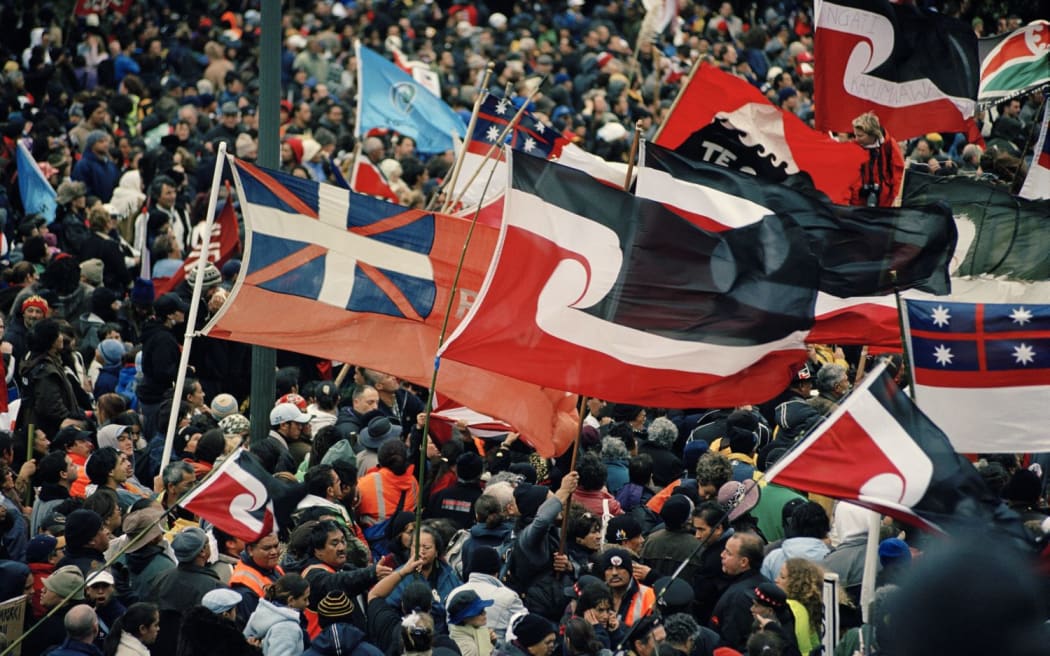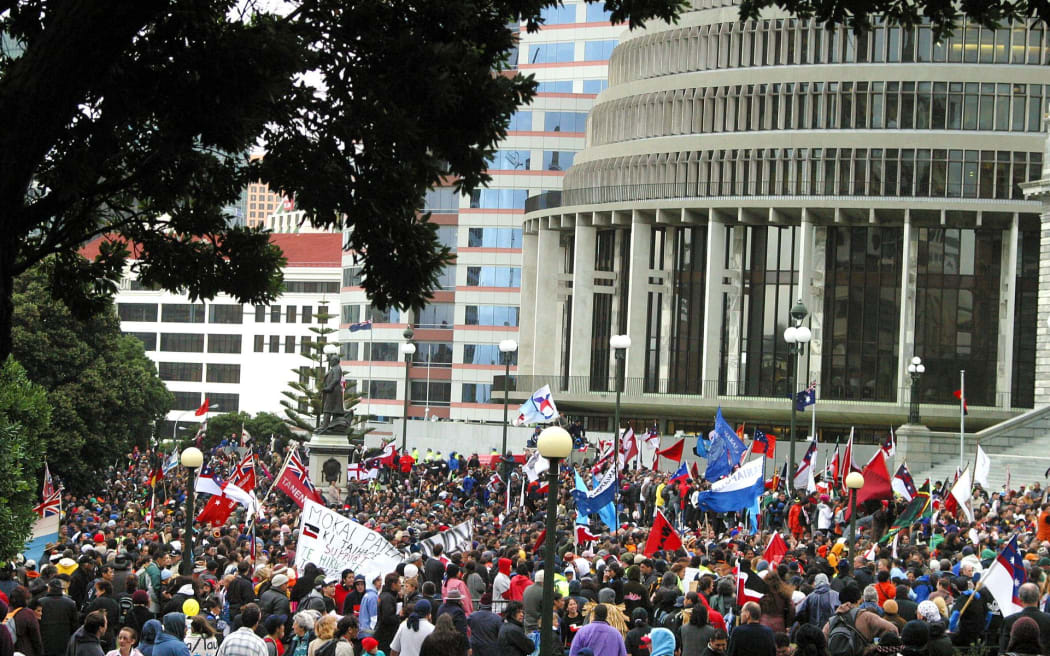
A host of flags accompanied the many thousands of marchers protesting against foreshore and seabed legislation in 2004. On the right is the first New Zealand flag; also prominent is the tino rangatiratanga flag, a flag of self-determination, designed in 1989–90. Photograph by Michael Hall. Museum of New Zealand Te Papa Tongarewa, MA_E.003515. p285 Photo:
Twenty years have passed since the historic hīkoi against the controversial Foreshore and Seabed Act reached Parliament.
The hīkoi - the largest in a generation - began in Te Hiku-o-te-Ika, the Far North, and by the time it reached Pōneke numbers had grown to at least 15,000.
During the last leg of the journey - from Te Papa to the Beehive - marchers chanted 'Hīkoi ki pāremata,' waving Tino Rangatiratanga flags. One banner read 'Māori Seabed, For Shore!'
The movement was a result of controversy caused by the then Labour-led government, which passed legislation giving ownership of the foreshore and seabed to the Crown.
It started in 2003, a year earlier, when the Court of Appeal had ruled the Māori Land Court had the jurisdiction to determine if the foreshore and seabed was customary Māori land. In response, the government put forward the Foreshore and Seabed Act 2004, which gave ownership of Aotearoa's coastline to the Crown - except parts privately owned.
The legislation meant Māori could no longer seek customary title over their traditional coastal areas. It also prevented the Māori Land Court from investigating applications relating to the foreshore and seabed and removed the High Court's power to determine claims for customary title.
Many Māori compared the act to a modern day raupatu, or land confiscation.
The ripples of the hīkoi flowed across all of Māoridom - the next year political waiata flooded the stage at Te Matatini.
That year's champions Te Kapa Haka o Te Whānau-a-Apanui called out Labour's Māori MPs directly in their winning waiata ā-ringa (action song).
"Tamihere! E here ana tāua, e Tā. Ka whakarongo mai e ngā ture hamupaka a te iwi Pākehā e tautute ana ki ngā kupu nui o Te Tiriti e," they sang.
Prime Minister Helen Clark and her government were heavily criticised for the legislation. But she did not hold back airing her frustrations with those who opposed it.
"What it is, is the same old faces - the Ken Mairs, the Harawira families, the Annette Sykes - the haters and wreckers," said Helen Clark.
In a speech to the Human Rights Commission Speakers Forum, then Deputy Prime Minister Michael Cullen also justified the bill.
"The bill provides general rights of public access in, on, over and across the public foreshore and seabed and general rights of navigation."
Cullen maintained the bill ensured Māori rights and interests would be protected.
"It upholds the mana of Māori and tikanga Māori, and recognises 'te kaitiakitanga o Tangaroa' - the guardianship of the sea and its resources - as an intrinsic part of what it is to be Māori, and as a key consideration in the sustainable management of the sea and all its resources.
"It also formally recognises Māori ancestral connections - based on tikanga and tupuna connection - so that in the future those who manage the marine area, and people who want to do things in the marine area, won't be able to say that they didn't consult with Māori because they didn't know who to talk to."

An estimated 10,000 people at Parliament after the Hikoi to protest the proposed seabed and foreshore legislation. Photo: AFP
Opposition leader of the National Party Don Brash thought the act did not go far enough. In his infamous speech at the Orewa Rotary Club he said New Zealand was in an "entrenched Treaty grievance industry."
There was even dissent with Labour itself, when minister Tariana Turia and Nanaia Mahuta indicated they would vote against the bill.
Turia left the party soon after and went to create her own - the Māori Party - which went on to win four of the seven Māori Seats at the next election.
Labour won reelection that year, but three years later they were defeated by the National Party led by John Key. The new National-led government ultimately repealed the act with the support of the Māori Party in 2010, replacing it with the Takutai Moana Act.
Iwi, hapū, and whānau Māori across the mōtu still reference the historic movement, which changed the political landscape of Aotearoa forever.



